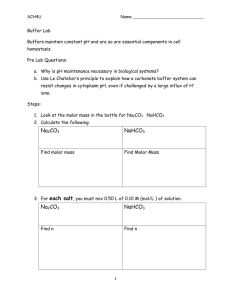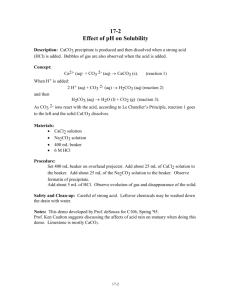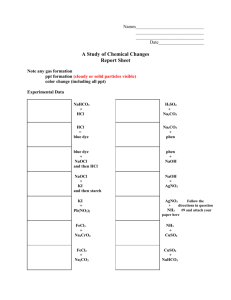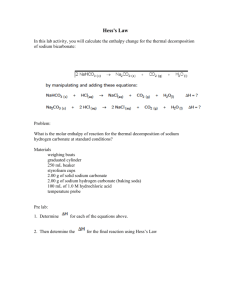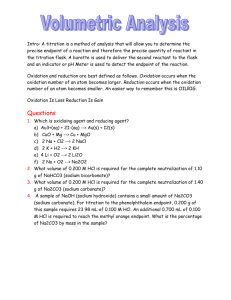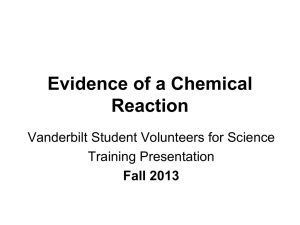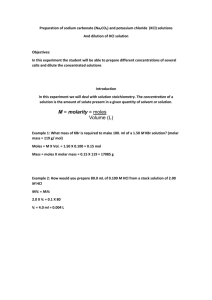Lesson - Vanderbilt University
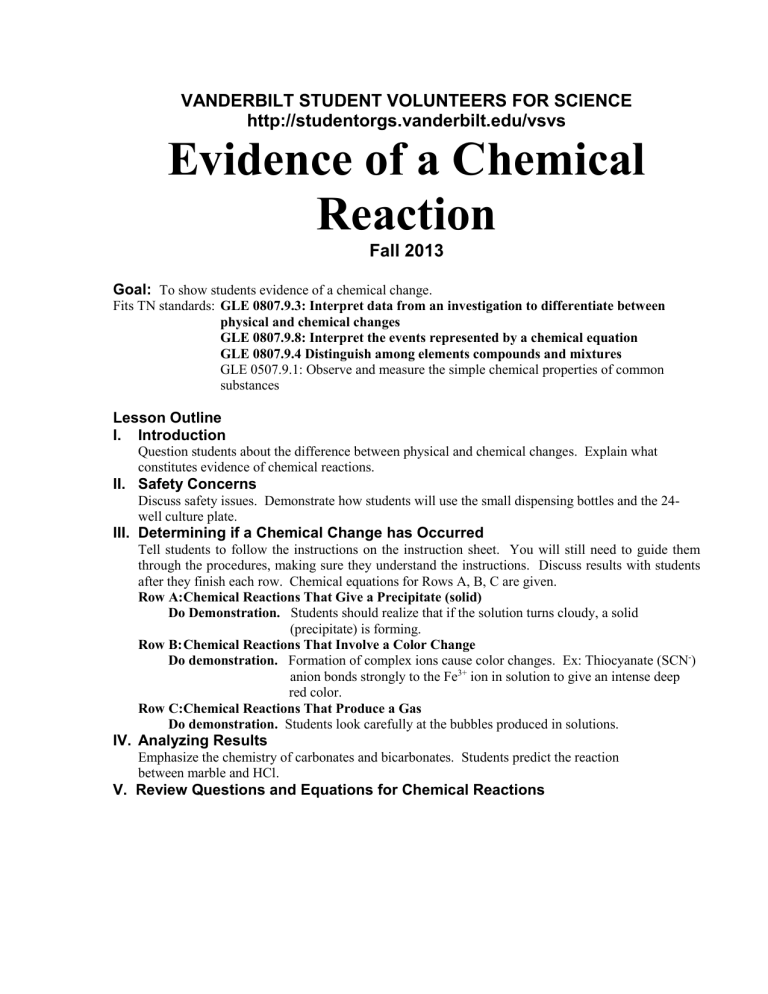
VANDERBILT STUDENT VOLUNTEERS FOR SCIENCE http://studentorgs.vanderbilt.edu/vsvs
Evidence of a Chemical
Reaction
Fall 2013
Goal:
To show students evidence of a chemical change.
Fits TN standards: GLE 0807.9.3: Interpret data from an investigation to differentiate between physical and chemical changes
GLE 0807.9.8: Interpret the events represented by a chemical equation
GLE 0807.9.4 Distinguish among elements compounds and mixtures
GLE 0507.9.1: Observe and measure the simple chemical properties of common substances
Lesson Outline
I. Introduction
Question students about the difference between physical and chemical changes. Explain what constitutes evidence of chemical reactions.
II. Safety Concerns
Discuss safety issues.
Demonstrate how students will use the small dispensing bottles and the 24well culture plate.
III. Determining if a Chemical Change has Occurred
Tell students to follow the instructions on the instruction sheet. You will still need to guide them through the procedures, making sure they understand the instructions.
Discuss results with students after they finish each row. Chemical equations for Rows A, B, C are given.
Row A: Chemical Reactions That Give a Precipitate (solid)
Do Demonstration. Students should realize that if the solution turns cloudy, a solid
(precipitate) is forming.
Row B: Chemical Reactions That Involve a Color Change
Do demonstration.
Formation of complex ions cause color changes. Ex: Thiocyanate (SCN )
anion bonds strongly to the Fe 3+ ion in solution to give an intense deep
red color.
Row C: Chemical Reactions That Produce a Gas
Do demonstration. Students look carefully at the bubbles produced in solutions.
IV. Analyzing Results
Emphasize the chemistry of carbonates and bicarbonates. Students predict the reaction between marble and HCl.
V. Review Questions and Equations for Chemical Reactions
Materials
34 safety goggles for students and VSVS members ( in a separate box )
15
15
24-well culture plates with lids plastic plates (to catch any spillage from well plates)
1 Demonstration Bag A - contains (1) 2 oz bottle of 0.1 M CaCl
Na
2
CO
3
, (2) 10 oz clear cups
1 Demonstration Bag B – contains (1) 2 oz bottle of 0.05 M Na
2
0.01 M I
2
, (2) 10 oz clear cups teaspoon, and (1) 10 oz clear cup
2
, (1) 2 oz bottle of 2.5 M
S
2
O
3
, (1) 2 oz bottle of
1 Demonstration Bag C - contains (1) 2 oz bottle of 1 M HCl, (1) jar of Na
2
CO
3
, (1)
15 Ziploc bags containing the following:
6 plastic droppers (in a Ziploc bag) containing bottles of the following solutions
1.0 M HCl
2.5 M Na
2
CO
3
0.5 M NaHCO
3
0.1 M Cu(NO
3
)
2
0.1 M Fe(NO
3
)
3 hydrochloric acid sodium carbonate sodium bicarbonate copper (II) nitrate
0.1 M KSCN iron (III) nitrate potassium thiocyanate
15 small pieces of marble CaCO
3
(in a small bag)
1 binder containing:
17 Instruction Sheets in sheet protectors (one per student)
34 Student observation sheets
1 pencil per student (Students should use their own pencils.)
2 sets of 1oz dropper bottles of each of the following unknowns:
Unknown A: Na
2
CO
Unknown B: CaCl
Unknown C: HCl
2
3
Unknown D: KSCN
Unknown E: NaHCO
3
While one team member starts the introduction, another should write the following vocabulary words on the board: physical change chemical change solution precipitate chemical reaction compound formula mixture
I. Introduction
Ask students: What is the difference between a physical change and a chemical change?
Be sure to include the following information in the discussion:
A physical change does not change the chemical properties of a substance. o No new substance is formed during a physical change. o Only the physical properties are changed. o Examples of physical changes include changes in the size, shape, or state of matter. For example, ice, liquid water, and steam. In each of these states, water has physically changed (from solid, liquid, gas) but not chemically.
A chemical change does change the chemical properties of a substance. o One or more new substances are formed in a chemical change. o A chemical change cannot be easily reversed. o Examples include: burning paper, digestion of food, bananas browning
Ask students: How can you tell when a chemical change has occurred? Some possibilities include: a gas given off, color change, precipitation, explosion, burning, etc.
Tell students what to look for to determine if a chemical change has occurred:
When solutions of two compounds are mixed, it is often possible to determine whether or not a chemical reaction has occurred through visual observation.
Evidence of a chemical change might be a color change , a gas given off (it may smell) , the formation of a precipitate (a new solid), or an energy (temperature, light) change.
Write these observations on the board and share the following explanation with students.
A color change occurs when two solutions are mixed and a new color is produced.
o BUT, if the color of one solution becomes a paler shade, that change is caused by dilution from the other solution and does not qualify as a color change.
Bubbles or fizz indicate that a gas is given off . o BUT, make sure that students understand that the bubbles given off in a soda pop drink is
NOT evidence of a chemical change This is just excess gas that is released when the top is opened. Carbonated beverages contain carbon dioxide gas dissolved under pressure, and removing the top lowers the pressure and allows carbon dioxide bubbles to escape.
A precipitate forms when two substances react to give a new solid compound that does not dissolve in water. o A precipitate may look like a cloudy solution, fine grains in a solution, a swirl, or a fluffy solid.
Note: When two clear solutions are mixed and a white precipitate forms, this whitish color does not count as a color change. The change should be recorded only as the formation of a precipitate.
An energy change can be either a physical or chemical change. These changes will be studied in the Endothermic/Exothermic lesson. A chemical energy change occurs in a lightstick when chemicals mix to produces light. A physical energy change occurs when you freeze water. Energy is removed from water, causing the water to freeze and its temperature to change.
Important: Scientists do not rely on just visual observations to determine if a chemical or physical change has occurred. The only real evidence is the formation of new substances, with different chemical formulas from the reactants.
II. Safety Concerns
Tell students they must put on safety goggles before mixing any solutions.
If anyone gets any of the chemicals on their skin or in their eyes, they should flush immediately with water. Although the solutions are dilute, they could still cause eye damage, especially the
1.0 M HCl.
Emphasize to students how important it is for them to follow directions.
Your Notes:
______________________________________________________________________________
______________________________________________________________________________
______________________________________________________________________________
______________________________________________________________________________
Organize students in pairs and distribute the following materials to each pair of students:
2 safety goggles
1 24-well culture plate
1 plastic plate
1 Ziploc bag containing 6 dropper bottles of solutions
2 Instruction Sheets
2 Chemical Reactions Observation Sheets
VSVS volunteers should put on their safety goggles and keep them on until students are finished mixing chemicals.
Have students look at the 24-well plate and the instructions at the top of the Chemical Reactions Lab Sheet.
Show students how to find the letters A, B, C, D as well as the numbers 1 - 6 on the 24-well plate. (Letters are imprinted in the plastic along the right side; numbers are imprinted across the top and the bottom. These are tiny and may be difficult to see.)
Show students how to match th e grid on the lab sheet to
letters
the 24-well plate . Tell students to place the 24-well plate on the plastic plate.
numbers
Give the following instructions to the students:
1.
The formulas of the compounds being used in a reaction are listed on the observation sheet.
The labels on the dropper bottles list both the name and formula. of the compounds.
Show students how to be careful when matching the formulas
(some of the formulas are very similar) .
2.
Show students one of the bottles and demonstrate how to get drops out of the bottle. Dropper bottles are easy to use. Apply slow, gentle pressure. Do not remove the red cap from a bottle until it is to be used. Put the cap back on the bottle immediately after use.
When using two solutions, put a squirt of the first solution in the correct well so that it is one-fourth full (we do not want students to spend time counting drops). Then add one squirt of the second solution. The well should now be half full.
3.
Tell students they will perform the reactions for one row only then stop and discuss the results with the VSVS members. Tell the partners to take turns doing the experiments as they follow the grid on the lab sheet. Both students record their observations on the lab sheet. Students can record NR if No
Reaction occurs. Otherwise, they will record color change, gas given off, or precipitate formed.
Your Notes:
______________________________________________________________________________
______________________________________________________________________________
______________________________________________________________________________
______________________________________________________________________________
4.
Tell students to follow the instructions on the instruction sheet for mixing solutions. (The instruction sheet lists the same directions as are given below.)
III. Determining If a Chemical Change Has Occurred
One team member should draw a grid of the well plate on the board with all of the rows labeled.
Write on this when discussing the results with the students.
Note: VSVS volunteers need to monitor the students closely to be sure contamination does not occur.
Ensure that students use the correct bottle.
Stop and discuss results with students after each row. This is preferable to waiting until students finish all of the experiment since some will finish very quickly and then be bored waiting for others to catch up.
The beginning of each reaction is given on the student observation sheet. Students and VSVSers should complete each equation on the board after the reactions in each row are completed.
A. Chemical Reactions that Give Precipitates - Row A
Demonstration: Show students what a precipitate looks like by doing the following demonstration.
Take the demonstration bag marked ROW A. Remove the 2 oz bottles of solutions and the two 10 oz clear cups. Empty each 2 oz bottles into separate cups. Hold the two cups up so the students can see what happens, and then pour one solution into the other. A white solid (precipitate) forms. Point this out as an example of a chemical reaction in which a precipitate forms to the students.
Tell students to use the grid on the lab sheet to perform the experiments in Row A.
Note: For each activity DO NOT record the results until the students have completed the experiments for the row since they may wait to copy the answers from the board.
Your Notes:
______________________________________________________________________________
______________________________________________________________________________
______________________________________________________________________________
______________________________________________________________________________
Review and Equations:
Ask students what evidence indicated that a chemical reaction occurred. o A precipitate formed in A1 and A2.
Put the results on the board. A1: precipitate A2: precipitate
Write the following equations on the board:
Demo: CaCl
2
(aq) + Na
2
A1: 2 Fe(NO
A2: Cu(NO
3
)
3
2
)
3
CO
3
(aq)
(aq) + 3 Na
(aq) + Na
2
2
CO
CO
3
→
3
CaCO
3
(s) + 2 NaCl (aq)
(aq) → Fe
(aq) → CuCO
2
(CO
3
3
)
3
(s) + 6 NaNO
(s) + 2 NaNO
3
(aq)
3
(aq)
B. Chemical Reactions that Involve a Color Change - Row B
Demonstration: Show students what a color change looks like by doing the following demonstration.
Take the demonstration bag marked ROW B. Remove the 2 oz bottles of solutions and the two
10 clear plastic cups. Empty each 2 oz bottles into separate cups. Hold the two clear containers up, and tell students to notice that one is a clear colorless solution and the other is a clear, brown solution. Pour the colorless solution into the brown solution, and ask students to describe what happens. The brown solution turns colorless, but it is still clear (i.e no precipitation). Explain to students that a chemical reaction has taken place because the brown solution turned colorless upon addition of the clear solution.
Tell students to use the grid on the lab sheet to perform the experiments in Row B.
Background for VSVS Members Only: This is an oxidation-reduction reaction in which iodine is reduced to iodide ion, and thiosulfate ion, S
2
O
4
2, is oxidized to tetrathionate ion, S
4
O
6
2.
Review and Equations:
Ask students what evidence indicated that a chemical reaction occurred. o A color change occurred.
Put the results on the board. B1 : color change to deep red B2: color change to pale green.
Write the following equations on the board:
Demo: I
2
(aq) + 2 Na
2
S
2
O
3
(aq) → 2 NaI(aq) + Na
2
S
4
O
6
(aq)
B1: Fe(NO
3
)
3
(aq) + KSCN (aq) → Fe(SCN)(NO
3
B2: Cu(NO
3
)
2
(aq) + KSCN (aq) → Cu(SCN)(NO
)
2
(aq) + KNO
3
(aq)
3
) (aq) + KNO
3
(aq) pale green color
Your Notes:
______________________________________________________________________________
______________________________________________________________________________
______________________________________________________________________________
______________________________________________________________________________ intense red color
Background for VSVS Members Only: Color changes with metal ion solutions are caused by the formation of complex ions. In the present case, the SCN - (thiocyanate) anion bonds strongly to the
Fe 3+ (iron) ion in solution to give a intense deep red color. The SCN anion also bonds to Cu(II)
(copper) ion.
C. Chemical Reactions that Produce a Gas - Row C
Note: Tell students they will have to look very closely and quickly as soon as they add the second solution to the first solution. The bubbles of gas are small and come off as soon as the solutions are mixed.
Demonstration: Show students what a chemical change that produces a gas looks like by performing the demonstration first.
Take the demonstration bag marked ROW C. Hold the cup up and ask students to watch very carefully what happens. Put 1 teaspoon of the solid (Na
2
CO
3 bottle (HCl) into it. Ask students to describe what happens.
) into the cup and empty the 2 oz o A bubbling up (slight foaming) which quickly subsides indicates a gas is given off. Tell students to watch very carefully for bubbles of gas when they are doing Row C because they may be difficult to see.
Tell students to use the grid on the lab sheet to perform all the experiments in Row C.
Review and Equations:
Ask students what evidence indicated that a chemical reaction occurred. o Bubbles/gas was given off.
Put the results on the board. C1 : bubbles/gas C2: bubbles/gas
Write the following equations on the board:
Demo: Na
2
CO
C1: NaHCO
3
C2: Na
2
CO
3
3
(s) + 2HCl (aq) → 2NaCl (aq) + CO
(aq) + HCl (aq) → NaCl (aq) + CO
(aq) + 2HCl (aq) → 2NaCl (aq) + CO
2
2
2
(g) + H
2
(g) + H
2
(g) + H
2
O (l)
O (l)
O (l)
Your Notes:
______________________________________________________________________________
______________________________________________________________________________
______________________________________________________________________________
______________________________________________________________________________
IV. Analyzing Results
Carbonates:
Write CO
3
2 on the board and tell students that formulas that include “CO are called carbonates . The carbonate ion has 2 negative charges on it.
3
” as part of the formula
One form of carbonate, sodium carbonate is commonly referred to as "washing soda." It is part of many laundry detergents and dish washing detergents.
Tell students to look at the ingredients of the copy of a washing soda box on their Instruction sheet. Sodium carbonate is listed as an ingredient.
Bicarbonates:
Write HCO
3
on the board and tell students that formulas that include “HCO
3
” as part of the formula are called bicarbonates . The bicarbonate ion has 1 negative charge associated with it.
A common source of bicarbonate is baking soda , whose scientific name is sodium bicarbonate.
Sodium bicarbonate is used for baking and as a deodorizer. Tell students to look at the ingredient label on baking soda and notice it says sodium bicarbonate .
Reactions of Carbonates and Bicarbonates:
Ask students to look at each box in row C and circle the formulas that have “CO
3
” part of the formula. .
or “HCO
3
” as
Write HCl on the board.
o Tell students that HCl is an acid called hydrochloric acid. o Tell students to put boxes around all the HCl’s in Row C.
Ask students what happened in row C when an acid was added to a carbonate or bicarbonate. A gas was given off.
Ask students if they have ever made a “volcano” at home or at school. Ask students if they remembered what they added to make the “lava”. Most likely, they used vinegar and baking soda. Vinegar is an acid, and when added to baking soda (sodium bicarbonate), it bubbles as it releases a gas.
Ask students what happens when you add an acid to carbonate or bicarbonate. When an acid is added to a carbonate or bicarbonate a chemical reaction occurs . This is evidenced by the fact that a gas is given off .
Tell students that the gas given off in these reactions is carbon dioxide.
Identifying Carbonates Using Chemical Reactions:
Tell students that chalk, limestone and marble are all calcium carbonate. If the formula for calcium carbonate is CaCO
3 ,
what might happen if an acid (HCl) is added to marble? It will bubble (give off a gas).
Write the first half of the equation, CaCO
3
(s) + HCl (aq) → ... on the board, and ask students to hypothesize what will happen, and what the products will be.
The gas will be CO
2.
Your Notes:
______________________________________________________________________________
______________________________________________________________________________
______________________________________________________________________________
______________________________________________________________________________
The full equation is:
CaCO
3
(s) + 2HCl (aq) → CaCl
2
(aq) + CO
2
(g) + H
2
O (l)
Have VSVS members hand out a piece of marble to each pair of students. Tell students that they are going to test their hypothesis to see if the marble will bubble when HCl is added.
Have students add the marble to C5 and to squirt some HCl into the well. Ask students what happened. Was their hypothesis correct? Yes, it should bubble when HCl is added.
Tell students that many statues are made of limestone and marble. Ask students what they think happens to statues when acid rain falls on them. The carbonate in the statue reacts with acid liberating a gas and causing the statue to decompose.
Background Information (in case students ask about acid rain) : Acid rain is caused by the presence of varying amounts of sulfuric acid and nitric acid. Fossil fuels, particularly coal and oil, contain sulfur as an impurity. When fossil fuels are burned, the sulfur combines with oxygen to form sulfur oxides that are gases released into the air. When it rains, the water reacts with these gases to form sulfuric acid. When vehicles burn gasoline or diesel fuel, nitrogen oxides are emitted into the air, and these react with water to produce nitric acid. The amount of sulfuric acid and nitric acid in acid rain depends on the location. The acid rain in Nashville is primarily caused by nitric acid from the high density of vehicles, while the acidity of rain in industrialized areas will be caused by the presence of both sulfuric and nitric acids. As a result of the Clean Air Act, industrial and power plants are emitting much lower amounts of sulfur oxides; however, the emission of nitric oxides from vehicle exhausts is still a problem.
V. Optional: Identifying an Unknown
Tell students they will be given a colorless solution that contains one of the following compounds dissolved in water
Unknown A: Na
2
CO
Unknown B: CaCl
2
3
Unknown C: HCl
Unknown D: KSCN
Unknown E: NaHCO
3
These are the same colorless solutions that they have been doing the experiments with.
Tell them that they will follow a plan, using the dropper bottles from the chemical reaction kit, to determine the identity of the unknown.
Students can work in pairs, groups, or as a class.
Distribute the 10 unknown dropper bottles throughout the class, so that pairs or groups of students have access to one unknown.
Your Notes:
______________________________________________________________________________
______________________________________________________________________________
______________________________________________________________________________
______________________________________________________________________________
Tell students to:
1.
Follow the plan in Row D and add a squirt of their unknown to the 6 wells in Row D of the well plate.
2.
Add a few drops from their known dropper bottles, one well at a time.
3.
Write down the observation immediately after each addition.
4.
Look at the results in Rows A, B and C, including the demonstration reactions, to determine what the possible reactions are. a.
What do you think your unknown is? _____________
If there is more than one possibility, list both. Can’t distinguish between Na
2
CO
3
or NaHCO
3 since both form a precipitate with CaCl
2
and both give off a gas with HCl. b.
What is your proof for what you’ve listed in (a)?
The proof should be stated something like the answer response in the plans given above but specific for the unknown. For example, if the unknown was CaCl
2
, the proof statement could be: A precipitate formed when Na
2
CO
3
solution was added. The CaCl
2 solution is the only one of the possible unknowns that will give a precipitate with Na
2
CO
3
. c.
Write balanced chemical equations for the reactions you used to determine the identity of the unknown.
Refer to equations in lesson (Section VIII)
3. Now that you’re finished, which pair of compounds listed above cannot be completely identified because of their similarity in reactions with solutions in the dropper bottles from the chemical reaction kit? Can’t distinguish between Na
2
CO
3
or NaHCO
3
since both form a precipitate with
CaCl
2
and both give off a gas with HCl.
Answer these questions after finishing the chemical reactions observation sheet.
1.
Write complete, balanced equations for the following: a.
One reaction in Row A that gave a precipitate.
Refer to equations in lesson (Section VIII) b.
One reaction in Row B that gave a color change.
Refer to equations in lesson (Section VIII) c.
One reaction in Row C that gave a gas.
Refer to equations in lesson (Section VIII)
VI. Review Questions
Ask students :
What is a physical change?
What is a chemical change?
How do we know when a chemical change has occurred? (answer on p. 3)
Your Notes:
______________________________________________________________________________
______________________________________________________________________________
______________________________________________________________________________
______________________________________________________________________________
VII. Clean-up
Have students put the dropper bottles back in the Ziploc bag. Make sure that the bottles are all upright. Leaks make for nasty clean-up tasks.
Collect the Ziploc bags and the goggles.
Place the lids on the 24-well plates and carefully put them in the Rubbermaid container. Place the lid on the Rubbermaid container and put it in the bottom of the box. (If you can rinse them out at the school, do so, PLEASE)
Place the ziploc bags and other materials in the box.
Collect all instruction sheets in sheet protectors and put them in the box.
Chemical Equations for Chemical Reactions in this Lesson
Abbreviations: s = solid, aq = aqueous, g = gas, l = liquid, NR = no reaction
Row A (precipitate)
Demo: CaCl
2
(aq) + Na
2
CO
3
(aq) → CaCO
3
(s) + 2 NaCl (aq)
A1: 2 Fe(NO
3
)
3
(aq) + 3 Na
2
CO
3
(aq) →Fe
2
(CO
3
)
3
(s) + 6 NaNO
3
(aq)
A2: Cu(NO
3
)
2
(aq) + Na
2
CO
3
(aq) → CuCO
3
(s) + 2 NaNO
3
(aq)
Row B: (color change)
Demo: : I
2
(aq) + 2 Na
2
S2O
3
(aq) → 2 NaI(aq) + Na
2
S
4
O
6
(aq)
B1: Fe(NO
3
)
3
(aq) + KSCN (aq) → Fe(SCN)(NO
3
)
2
(aq) + KNO
3
(aq)
B2: Cu(NO
3
Row C:
)
2
(aq) + KSCN (aq) → Cu(SCN)(NO
3
) (aq) + KNO
3
(aq)
Demo Na
2
CO
3
(s) + 2HCl (aq) → 2NaCl (aq) + CO
2
(g) + H
2
O (l)
C1: NaHCO
3
(aq) + HCl (aq) → NaCl (aq) + CO
2
(g) + H
2
O (l)
C2: Na
2
CO
3
(aq) + 2HCl (aq) → 2NaCl (aq) + CO
2
(g) + H
2
O (l)
C5: CaCO
3
(s) + 2HCl (aq) → CaCl
2
(aq) + CO
2
(g) + H
2
O (l)
Lesson written by Dr. Melvin Joesten, Chemistry Department, Vanderbilt University
Pat Tellinghuisen, Coordinator of VSVS, Vanderbilt University
Your Notes:
______________________________________________________________________________
______________________________________________________________________________
______________________________________________________________________________
______________________________________________________________________________
Chemical Reactions Observation Sheet
Name________________________________
Vocabulary Words: physical change, chemical change, chemical reaction, formula , solution, precipitate, compound, mixture
In each box, use the following choices to record your observations: color change, precipitate formed, gas given off, NR (no reaction)
Add other observations if you wish. Ex: lots of bubbles, fizz, small or large bubbles, cloudy precipitate.
A1
Fe(NO
3
)
3
+ Na
2
CO
3
B1
Fe(NO
3
)
3
+KSCN
A2
Cu(NO
3
)
2
+ Na
2
Cu(NO
3
)
2
+
CO
3
KSCN
A3 A4 A5 A6
Demonstration
CaCl
2
+ Na
2
CO
3
B6 B2 B3 B4 B5
Demonstration
I
2
+ 2 Na
2
S2O
3
C1 C2 C3 C4 C5 C6 baking soda
NaHCO
3
+ HCl washing soda
Na
2
CO
3
+ HCl marble solid
CaCO
3
+ HCl
Demonstration
Na
2
CO
3
+ 2HCl
D1 baking soda
NaHCO
3
+ unknown
D2 washing soda
Na
2
CO
3
+ unknown
D3 potassium thiocyanate
KSCN
+ unknown
D4 iron nitrate
Fe(NO
3
)
3
+ unknown
D5 copper nitrate
Cu(NO
3
)
2
+ unknown
D6 hydrochloric acid
HCl
+ unknown
HCl - hydrochloric acid Na
KSCN -
2
CO
3
sodium carbonate NaHCO
potassium thiocyanate CaCl
2
-
3
sodium bicarbonate Cu(NO calcium chloride NaHCO
3
baking soda Na
2
3
)
CO
2
copper (II) nitrate Fe(NO
3
sodium carbonate
3
)
3
iron (III) nitrate
A1
Fe(NO
3
)
3
+ Na
2
CO
3 precipitate
B1
Fe(NO
3
)
3
+KSCN color change- deep red
A2
Cu(NO
3
)
2 precipitate
+ Na
2
CO
3
B2
Cu(NO
3
)
2
+ KSCN color change - pale green color
B3
A3
Chemical Reactions Lab Sheet
Answer Key
A4
B4
A5
B5
A6
Demonstration
CaCl
2
+ Na
2
CO
3 white precipitate
B6
Demonstration
I
2
+ 2 Na
2
S2O
3 color change – brown to colorless
C6
Demonstration
Na
2
CO
3
+ 2HCl gas given off
C1 baking soda
NaHCO
3
+ HCl gas given off
C2 washing soda
Na
2
CO
3
+ HCl gas given off
C3 C4 C5 marble solid
CaCO
3
+ HCl gas given off
D1 baking soda
NaHCO
3
+ unknown
D2 washing soda
Na
2
CO
3
+ unknown
D3 potassium thiocyanate
KSCN
+ unknown
D4 iron nitrate
Fe(NO
3
)
3
+ unknown
D5 copper nitrate
Cu(NO
3
)
2
+ unknown
D6 hydrochloric acid
HCl
+ unknown
HCl - hydrochloric acid Na
2
CO
3
sodium carbonate NaHCO
3
sodium bicarbonate Cu(NO
3
)
2
copper (II) nitrate Fe(NO
3
)
3
iron (III) nitrate
KSCN potassium thiocyanate CaCl
2
calcium chloride NaHCO
3
baking soda Na
2
CO
3
sodium carbonate
baking soda
NaHCO
3
+ unknown
A (Na
2
CO
3
)
NR baking soda
NaHCO
3
+ unknown
B ( CaCl
2
)
PPT baking soda
NaHCO
3
+ unknown C (HCl)
Gas given off baking soda
NaHCO
3
+ unknown
D (KSCN)
NR baking soda
NaHCO
3
+ unknown
E ( NaHCO
3
)
NR washing soda
Na
2
CO
3
+ unknown
A (Na
2
CO
3
)
NR washing soda
Na
2
CO
3
+ unknown
B ( CaCl
2
)
PPT washing soda
Na
2
CO
3
+ unknown
C (HCl)
Gas given off washing soda
Na
2
CO
3
+ unknown
D (KSCN)
NR washing soda
Na
2
CO
3
+ unknown
E ( NaHCO
3
)
NR
Answer Sheet for Unknown Solutions potassium thiocyanate
KSCN+ unknown A
(Na
2
CO
3
)
NR iron nitrate
A (Na
2
CO
3
)
PPT
Fe(NO
3
)
3
+ unknown potassium thiocyanate
KSCN+ unknown B (
CaCl
2
)
NR potassium thiocyanate
KSCN + unknown C
(HCl)
NR potassium thiocyanate
KSCN + unknown D
(KSCN)
NR potassium thiocyanate
KSCN + unknown E
( NaHCO
3
)
NR iron nitrate
Fe(NO
3
)
3
+ unknown
B ( CaCl
NR
2
) iron nitrate
Fe(NO
3
)
3
+ unknown
C (HCl)
Color change iron nitrate
Fe(NO
3
)
3
+ unknown
D (KSCN)
Color change iron nitrate
Fe(NO
3
)
3
+ unknown
E ( NaHCO
3
)
PPT copper nitrate
Cu(NO
3
)
2
+ unknown
A (Na
2
CO
3
)
PPT copper nitrate
Cu(NO
3
)
2
+ unknown
B ( CaCl
2
NR
) copper nitrate
Cu(NO
3
)
2
+ unknown
C (HCl)
Color change copper nitrate
Cu(NO
3
)
2
+ unknown
D (KSCN)
Color change copper nitrate
Cu(NO
3
)
2
+ unknown
E ( NaHCO
3
)
PPT hydrochloric acid
HCl + unknown A
(Na
2
CO
3
)
Gas given off hydrochloric acid
HCl + unknown B
( CaCl
2
)
NR hydrochloric acid
HCl + unknown C
(HCl)
NR hydrochloric acid
HCl + unknown D
(KSCN)
NR hydrochloric acid
HCl + unknown E
( NaHCO
3
)
Gas given off
Class Activity Sheet – Extension Activity
NAME _________________________________________________________
1.
Write complete, balanced equations for the following (choose a correct equation from the list below): a.
One reaction in Row A that gave a precipitate. b.
One reaction in Row B that gave a color change. c.
One reaction in Row C that gave a gas.
2. You will be given an unknown colorless solution that contains one of the following compounds dissolved in water: CaCl
2
, Na
2
CO
3
, KSCN, HCl, NaHCO
3
. Follow Row D to determine the identity of your unknown. a.
What do you think your unknown is? _____________ If there is more than one possibility, list both. b.
What is your proof for what you’ve listed in (a)? c.
Write balanced chemical equations for the reactions you used to determine the identity of the unknown. d.
Now that you’re finished, which pair of compounds listed above cannot be completely identified because of their similarity in reactions with solutions in the dropper bottles from the chemical reaction kit?
Can’t distinguish between Na
2
CO
3
or NaHCO
3
since both form a precipitate with CaCl
2 and both give off a gas with HCl.
Chemical Equations for Chemical Reactions in this Lesson
Abbreviations: s = solid, aq = aqueous, g = gas, l = liquid
CaCl
2
(aq) + Na
2
CO
3
(aq) → CaCO
3
(s) + 2 NaCl (aq)
2 Fe(NO
3
)
3
(aq) + 3 Na
2
CO
3
(aq) →Fe
2
(CO
3
)
3
(s) + 6 NaNO
3
(aq)
Cu(NO
3
)
2
(aq) + Na
2
CO
3
(aq) → CuCO
3
(s) + 2 NaNO
3
(aq)
I
2
(aq) + 2 Na
2
S2O
Fe(NO
3
)
3
3
(aq) → 2 NaI(aq) + Na
2
S
(aq) + KSCN (aq) → Fe(SCN)(NO
4
O
6
(aq)
3
)
2
(aq) + KNO
3
(aq)
Cu(NO
3
)
2
(aq) + KSCN (aq) → Cu(SCN)(NO
3
) (aq) + KNO
3
(aq)
Na
2
CO
3
(s) + 2HCl (aq) → 2NaCl (aq) + CO
2
(g) + H
2
O (l)
NaHCO
3
(aq) + HCl (aq) → NaCl (aq) + CO
2
(g) + H
2
O (l)
Na
2
CO
3
(aq) + 2HCl (aq) → 2NaCl (aq) + CO
2
(g) + H
2
O (l)
CaCO
3
(s) + 2HCl (aq) → CaCl
2
(aq) + CO
2
(g) + H
2
O (l)
Class Activity Sheet
ANSWER SHEET
Answer these questions after finishing the chemical reactions observation sheet.
2.
Write complete, balanced equations for the following: a.
One reaction in Row A that gave a precipitate.
Refer to equations below
One reaction in Row B that gave a color change.
Refer to equations below
One reaction in Row C that gave a gas.
Refer to equations in lesson (Section VIII)
2. 2. You will be given an unknown colorless solution that contains one of the following compounds dissolved in water: CaCl
2
, Na
2
CO
3
, KSCN, HCl, NaHCO
3
. Follow Row D to determine the identity of your unknown.
What do you think your unknown is? _____________
If there is more than one possibility, list both. Can’t distinguish between Na
2
CO
3
or NaHCO
3 since both form a precipitate with CaCl
2
and both give off a gas with HCl. d.
What is your proof for what you’ve listed in (a)?
The proof should be stated something like the answer response in the plans given above, but specific for the unknown. For example, if the unknown was CaCl
2
, the proof statement could be: A precipate formed when Na
2
CO
3
solution was added. The CaCl
2 solution is the only one of the possible unknowns that will give a precipitate with Na
2
CO
3
. e.
Write balanced chemical equations for the reactions you used to determine the identity of the unknown.
Refer to equations below
3. Now that you’re finished, which pair of compounds listed above cannot be completely identified because of their similarity in reactions with solutions in the dropper bottles from the chemical reaction kit?
Can’t distinguish between Na
2
CO
3
or NaHCO
3
since both form a precipitate with CaCl
2 and both give off a gas with HCl.
Instruction Sheet
Evidence that a Chemical Reaction Has Taken Place
I. Introduction
Discussion of the difference between a physical change and a chemical change
II. Preparation for Mixing Solutions
VSVS team demonstrates how to use the small dispensing bottles and the 24-well culture plate. Safety goggles must be worn while mixing any chemicals.
Students work in pairs.
1.
Look at the 24-well plate and the instructions at the top of the Chemical Reactions Lab Sheet.
2.
Find the letters A, B, C, D and the numbers 1 - 6 on the 24-well plate. (Letters are imprinted in the plastic along the right side; numbers are imprinted across the top and the bottom. These are tiny and may be difficult to see.)
3.
Match the grid on the lab sheet to the 24-well plate.
The VSVS team will go over the following instructions:
1. The formulas of the compounds being used in a reaction are listed for each specific well on the corresponding section of the lab sheet.
The labels on the dropper bottles list both the names and the formulas of the compounds. Be careful when matching the formulas (some of the formulas are very similar).
2. When using two solutions, put a small squirt of the first solution in the correct well. Then add one squirt of the second solution.
If the well is about one-fourth full after the first addition and about one-half full after the second addition, this will give good results. Be sure to use the correct bottle. Dropper bottles are easy to use. Apply slow, gentle pressure.
3. Record your observations on your lab sheets. Record NR if No Reaction occurs.
Otherwise, record color change, gas given off, or precipitate formed.
III. Mixing Solutions
Row A - Chemical Reactions that Give Precipitates
Watch a demonstration by VSVS volunteers that illustrates the formation of a precipitate.
If the solution turns cloudy, a solid (precipitate) is forming.
Place the 24-well plate on the plate. Partners should take turns doing the experiments as you follow the grid on the lab sheet to perform all the experiments in Row A. Both of you should record your observations on your lab sheet.
Row B - Chemical Reactions that Involve a Color Change
Watch a demonstration by VSVS volunteers that shows a reaction with a color change.
Use the grid on the lab sheet to perform the experiments in Row B.
Row C - Chemical Reactions that Produce a Gas
Watch a demonstration by VSVS volunteers that illustrates the production of a gas.
Use the grid on the lab sheet to perform all the experiments in Row C.
Look very closely and quickly as soon as you add the second solution to the first solution. The
bubbles of gas are small and come off as soon as the solutions are mixed.
IV. Analyzing Results
The results of the experiments are used to discuss the chemistry of carbonates and bicarbonates.
A VSVS team member will give you a piece of marble. Place the piece of marble into well C5 and add a squirt of HCl.
V. Optional – Identifying an Unknown.
1.
Each group uses 1 unknown.
2.
Follow the plan in Row D and add a squirt of your unknown to the 6 wells in Row D of the well plate.
3.
Add a few drops from your known dropper bottle, one well at a time.
4.
Write down the observation immediately after each addition.
5.
Look at the results in Rows A, B and C, including the demonstration reactions, to determine what the possible reactions are.
6. Complete the class activity sheet.
Review Questions
VI. Clean-up
Put the dropper bottles back in the Ziploc bag. Make sure that the dropper bottles are UPRIGHT.
